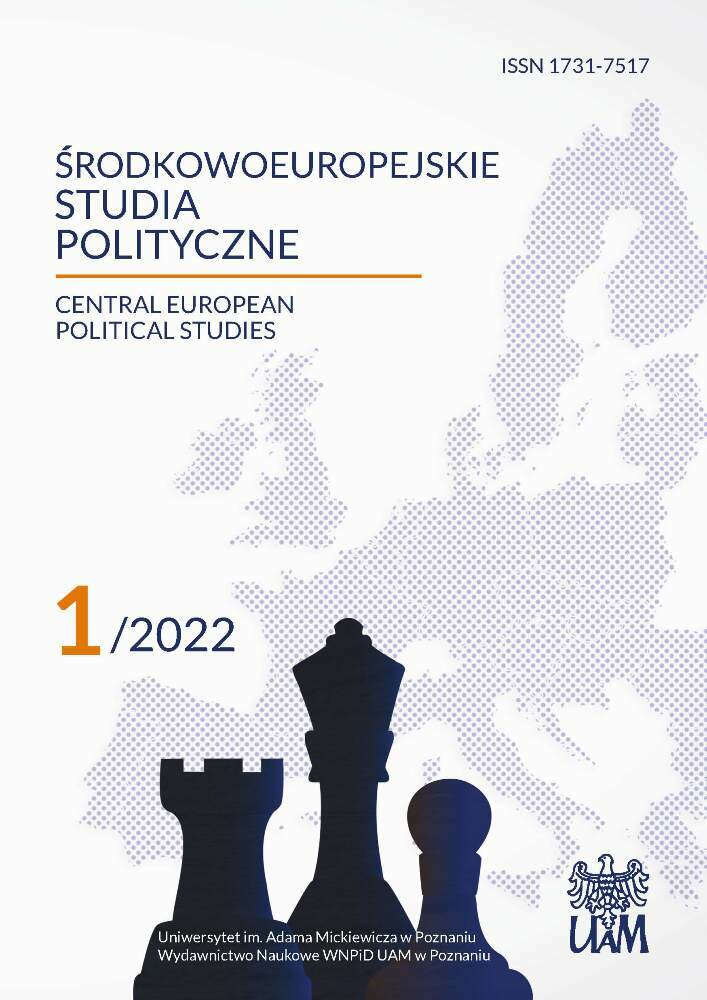Abstrakt
Przemiany polityczne w Rumunii zapoczątkowane w 1989 roku, po śmierci Nicole Ceausescu. Artykuł opisuje i analizuje dynamikę zmian instytucjonalnych i zachowań w procesach politycznych zachodzących w Rumunii po 1989 r. Artykuł koncentruje się na ramach konstytucyjnych najważniejszych instytucji. Autor analizuje rozumienie podejść teoretycznych do zmian politycznych i instytucjonalnych w kraju, a także ewolucję organów ustawodawczych, wykonawczych i sądownictwa – trzech filarów demokracji. Artykuł prezentuje jak partie polityczne uczestniczące w wyborach tworzą rząd i omawia stabilność instytucji. Artykuł analizuje podstawy instytucjonalne koalicji rządowej w latach 1990–2020 w okresie post-komunistycznej demokracji w Rumunii. Artykuł zaczyna się od przedstawienia założenia ram instytucjonalnych, iż systemy wyborcze oraz zapisy konstytucji dotyczące podziału władzy, struktury i relacji pomiędzy parlamentem a prezydentem determinują punkt rozproszenia lub koncentracji władzy w systemie politycznym.
Bibliografia
Agh A. (1998), Emerging Democracies in East-Central Europe and the Balkans, Books.
Alexandru I. (2016), Again, about Justice Independence and Its Relationships with the Parliament and Government, “Review. Universul Juridic”, p. 5.
Aniţei A. C. (2014), Post Mortem Assisted Reproductive Technology (Art) And the Particular Case of The Will in Romania, “Contemporary Legal Institutions” 6, no. 1.
Bharti S. S. (2020), Strengthening the Development Partnership between the EU and South Asia: A Contemporary Analysis, “Slovak Journal of Political Sciences”, 20(2), pp. 278–298, DOI: https://doi.org/10.34135/sjps.200205.
Bureau T. (2015), Migrant Political Participation and Voting Behaviour in Romania, Paper to be presented at APSA San Francisco 3–6 September.
Carey H. F. (1989), Romania since 1989: Politics, Economics, and Society, Lexington books.
Chamber of Deputies (2018), How Parliament of Romania Works, http://www.cdep.ro/pls/dic/site.page?id=108, 04 January 2022.
Chamber of Deputies (n.d.), Constitution of Romania 1991, http://www.cdep.ro/pls/dic/site.page?den=act1_2.
Chiva C. (2007), The institutionalisation of post-Communist parliaments: Hungary and Romania in comparative perspective, “Parliamentary Affairs” 60(2), pp. 187–211.
Constitutional Court of Romania (2011), National report on Separation of Powers and Independence of Constitutional Courts and Equivalent Bodies, https://www.venice.coe.int/WCCJ/Rio/Papers/ROM_Toader_E.pdf.
Constitution of Romania (2003), Constitution of Romania, http://www.cdep.ro/pls/dic/site.page?den=act2_2&par1=3, 04 January 2022.
ECPR (2016), Migrant Political Culture and Voting Behaviour in Romania, Toma Bureau and Gabriel Badescu Political Science Department Faculty of Political Science Public Administration and Communication Babes-Bolyai University, Cluj-Napoca, Romania, https://ecpr.eu/Filestore/PaperProposal/007bc7d4-dc45-4e1d-a333-dd1933a709fc.pdf, 04 January 2022.
European Election Database (1996), Romania: Parliamentary Election, http://www.nsd.uib.no/europeanelection database/country/Romania/parliamentaryelections.html, 02 June, 2022.
European Election Database (2004), Romania: Parliamentary Election 204), http://eed.nsd.uib.no/webview/index.jsp?study=http%3A%2F%2F129.177.90.166%3A80%2Fobj%2FfStudy%2FROPA2004_Display&mode=cube&v=2&cube=ttp%3A%2F%2F129.177.90.166%3A80%2Fobj%2FfCube%2FROPA2004_Display_C1&top=yes.
European Union (2007), Romania Overview, https://european-union.europa.eu/principles-countries-history/country-profiles/romania_en.
Fish M. S. (2006), Stronger legislatures, stronger democracies, “Journal of democracy” 17(1), pp. 5–20.
Foundation Robert Schuman (2014), Presidential election in Romania, 2nd November 2014, https://www.robert-schuman.eu/en/doc/oee/oee-1544-en.pdf.
Ganev V. I. (2013), Post-accession hooliganism: Democratic governance in Bulgaria and Romania after 2007, “East European Politics and Societies” 27(01), pp. 26–44.
Gonenc L. (ed.) (2002), Prospects for constitutionalism in post-communist countries, vol. 50, Martinus Nijhoff Publishers.
Huntington S. P. (1993), The third wave: Democratization in the late twentieth century, vol. 4, University of Oklahoma Press.
Ilie C. (ed.) (2010), European parliaments under scrutiny: Discourse strategies and interaction practices, vol. 38, John Benjamins Publishing.
Krastev I., Holmes S. (2019), How liberalism became ‘the god that failed’, https://www.theguardian.com/world/2019/oct/24/western-liberalism-failed-post-communist-eastern-europe, 07 March 2022.
Lord C., Erika H. (2017), Democracy in the new Europe, Bloomsbury Publishing.
Negrut V. (2017), Considerations on the Legal Regime Applicable to the Romanian Government Ordinances, “EIRP Proceedings” no. 12.
Nicolae M. J. (2010), Regional Analyses of Voting Behaviour in Romania–Local, General and Presidential Elections, “Romanian Journal of Regional Science” 4(2), pp. 62–77.
The permanent electoral authority (2022), Report on the Organization and Deployment for Election of Chamber of Deputies and Senate from November 30, 2008, p. 121–122, http://www.roaep.ro/, 04 January 2022.
Pirvulescu C. (2001), Local public administration in Romania, “Local Self Government and Decentralization in South-East Europe” 1000(2000), p. 225.
Robert Shuman (2009), Presidential Election in Romania 22nd November and 6th December 2009, https://www.robert-schuman.eu/en/eem/0956-presidential-election-in-romania-22nd-november-and-6th-december-2009.
Roper S. D. (1989), Parliamentary development, “Romania since”, pp. 159–177.
Romanian Constitution (2003), Romania’s Constitution of 1991 with Amendments through 2003, https://www.constituteproject.org/constitution/Romania_2003.pdf?lang=en.
Safta M. (2020), Aspects regarding the competence of the President of Romania in the Government’s investiture and the Ministers’ appointment, “Conferința Internaționala de Drept, Studii Europene și Relații Internaționale” 8 (VIII), pp. 103–112.
Saramet O. (2015), Executive Powers in Relations with the Parliament: Part I, “Agora Int’l J. Jurid. Sci”, p. 68.
Smilov D., Krastev I. (2008), The Rise of Populism in Eastern Europe: Policy Paper, in: Populist Politics and Liberal Democracy in Central and Eastern Europe, eds. G. Mesežnikov, O. Gyárfášová, S. Daniel, Bratislava.
Stanescu L. S. (2013), The Structure of The Romanian Parliament from The Perspective of Its Optimizing and Of the Cooperation Mechanism with The European Parliament, “The USV Annals of Economics and Public Administration” 12, no. 1 (15), pp. 244–255.
Sussex European Institute (2009), Romanian Presidential Elections, pp. 9–10, http://www.sussex.ac.uk/sei/1-4-2.html.
Tanase T. (2014), The electoral campaign through Social Media. Case Study 2014 Presidential elections in Romania, http://www.sferapoliticii.ro/sfera/183/pdf/183.09.Tanase.pdf, 04 January 2022.
Tanase T. (2015), The electoral campaign through Social Media. Case Study–2014 Presidential elections in Romania, “Sfera politician” 23(183/1), pp. 92–104.
The Constitutional Court of Romania (2003), The constitution of Romania Revised, https://www.ccr.ro/constitutia-romaniei-2003, 04 January 2022.
Vida I. C. (2014), Role and Attributions of The President of Romania In the Romanian State System, “Applied Social Sciences: Administration and Management”, p. 171.
Vilcu D. A. (2014), Romanian diaspora: The 2014 presidential elections as positive community practice, “Jurnalul Practicilor Comunitare Pozitive”, 14(4), pp. 113–127.
Licencja
Prawa autorskie (c) 2022 Mukesh Shankar BHARTI

Utwór dostępny jest na licencji Creative Commons Uznanie autorstwa 4.0 Międzynarodowe.

